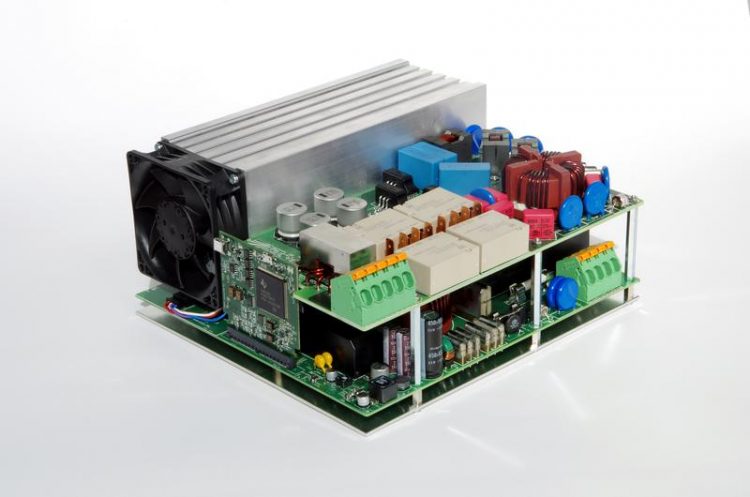Innovations in thermal and electric storage systems: Fraunhofer ISE at the Energy Storage Europe

The SiC inverter, developed at Fraunhofer ISE, is both highly efficient and particularly compact. © Fraunhofer ISE
In parallel, the 8th Energy Storage Europe Conference (ESE) and the 13th International Renewable Energy Storage Conference (IRES) is taking place, where Fraunhofer ISE researchers will present results in the fields of electrical and thermal energy storage.
Silicon-Carbide Synchronous Converter 25 kW
In the collaborative research project “OptiStore”, Fraunhofer ISE develops a highly efficient bidirectional converter with a maximum power of 25 kW.
The objective is to develop and test an innovative power self-consumption system based on a modular converter lithium-ion battery unit for optimum use of renewable energy sources in the commercial and industrial sectors.
The investment and operation costs of the entire system shall be cost-optimized yet at the same time have an efficiency greater than the typical systems found on the market today.
These contrary goals can only be reached with the newest silicon-carbide MOSFETs and an innovative design.
Thanks to a frequency of 96 Hz, the passive components can be designed smaller than usual, yet at the same time a very good efficiency of up to 99 % can be achieved.
https://www.ise.fraunhofer.de/en/research-projects/optistore.html
Three-Phase SiC-UPS Inverter
The highly compact inverter developed at Fraunhofer ISE for the uninterruptible power supply (UPS) reached efficiencies of up to 98.7 %. By using silicon carbide transistors, 10 kW power at a volume of only 5 liters could be realized.
The efficiency is particularly important for online UPS systems, since short voltage interruptions in the grid must be compensated while at the same time the consumer must be permanently supplied via the USP. These results can be transferred to other areas in power conversion where weight and efficiency play a large role.
Battery Stack for Stationary Applications
The prototype shown here is based on an aqueous cell chemistry and acts as a battery storage device for stationary applications. The device is inherently safe and in accordance with the objective (i.e. non-mobile applications) has not been optimized with respect to energy density but rather with respect to the lowest total cost of ownership (TCO).
Therefore, the sustainable and inexpensive materials were used for the manufacture. With its flexible architecture, the unit can be adapted to meet special requirements (e.g. high power). Fraunhofer ISE provides services in designing, constructing, testing and certifying electrochemical storage devices.
Sector Coupling with Hydrogen
The exhibit shows the possibilities of sector coupling with hydrogen. With its on-site solar hydrogen filling station and hydrogen feed-in plant, Fraunhofer ISE has two examples of the manifold possibilities for using hydrogen in the energy system. With the help of a PEM electrolyzer, electricity is used to split water and produce hydrogen, which is then stored in pressurized tanks or discharged directly into the respective sectors.
The hydrogen feed-in plant supplies the gas network with renewable gas. Fraunhofer ISE uses both platforms as research platforms to test new components for hydrogen and natural gas applications as well as to test new operating modes of electrolysis, refueling stations and feed-in plants.
The Department of Chemical Energy Storage at Fraunhofer ISE offers customers the opportunity to test their product developments in the practice on Fraunhofer ISE’s hydrogen plants. In addition, Fraunhofer ISE has many years of experience with the in-house developed simulation toolbox “H2ProSim”, which provides the key competence for the design and evaluation of complex hydrogen systems.
Woven Wire Heat Exchanger for Latent Heat Storage
Protoypes of woven wire heat exchangers are exhibited for latent heat storage that use phase change materials as storage medium. For operation a heat transfer fluid flows through the capillary tubes. The heat exchanger is surrounded by phase change material, or PCM, which melts and crystallizes respectively storing and releasing heat. The low thermal conductivity of PCM limits the thermal power of the storage.
In the prototypes shown, the surface area is enlarged by a applying a metal fabric to compensate the low thermal conductivity. The heat exchangers consist of capillary tubes with a diameter of 2 mm and 100 µm wire fabric which is welded to the tubes. The actual configuration of the fabric leads to a heat transfer surface that has three times the area of the bare tubes. Compared to conventional structures like fin wires, woven wires save material and greatly increase the surface area.
Talks from Fraunhofer ISE Researchers at the IRES Conference and the ESE Forum:
12.03. 15:10 h: Christian Bischoff
»Wässrige Zink-Ionen-Technologie für stationäre Batteriespeicheranwendungen« (ESE Forum)
13.03. 9:00 h: Björn Nienborg
»Ecological life cycle assessment of thermal energy storage concepts for building applications« in »Thermal«
13.03. 11:20 h: Sebastian Gamisch
»Transient Behavior of the Thermal Management for Cylindrical Li-Ion-Batteries based on Phase Change Material Composite« in »Batteries«
13.03. 12:00 h: Christopher Voglstätter
»Energy Network Freiburg – Hydrogen Generation And Feed-in In The Context Of Municipal Distribution Grids« in »Applications, Case Studies, System Analysis«
13.03. 12:20 h: Nikolas Knetsch
»Techno-economic Assessment Of Different Design And Operation Concepts Of A Power To Hydrogen Plant Fed By A Photovoltaics Power Plant« in »Storage on the move«
Further Information: https://www.energie.fraunhofer.de/en/events-trade-fairs/allianz-energy-storage_2…
https://www.ise.fraunhofer.de/en/press-media/press-releases/2019/energy-storage-…
Media Contact
All latest news from the category: Trade Fair News
Newest articles

NASA: Mystery of life’s handedness deepens
The mystery of why life uses molecules with specific orientations has deepened with a NASA-funded discovery that RNA — a key molecule thought to have potentially held the instructions for…

What are the effects of historic lithium mining on water quality?
Study reveals low levels of common contaminants but high levels of other elements in waters associated with an abandoned lithium mine. Lithium ore and mining waste from a historic lithium…

Quantum-inspired design boosts efficiency of heat-to-electricity conversion
Rice engineers take unconventional route to improving thermophotovoltaic systems. Researchers at Rice University have found a new way to improve a key element of thermophotovoltaic (TPV) systems, which convert heat…



